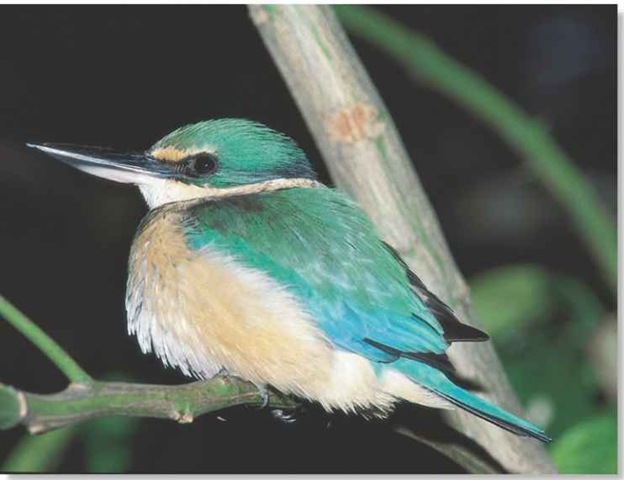ORDER
Coraciiformes
FAMILY
Alcedinidae
GENUS & SPECIES
KEY FEATURES
• Striking colors make it easily distinguishable
• Nestlings look more like hedgehogs than birds
• Patiently surveys territory from various ‘ vantage points before making a quick strike
• Despite its name, the sacred kingfisher prefers insects to fish
WHERE IN THE WORLD?
Wooded areas of Australia and New Zealand, near water and in scrub country; also on islands, including Kermadec, New Guinea and Guadalcanal
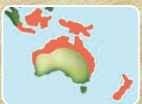
Lifecycle
Territorial and aggressive, the sacred kingfisher chases away potential enemies by displaying its striking colors and singing a series of loud warnings from its perch.
Habitat
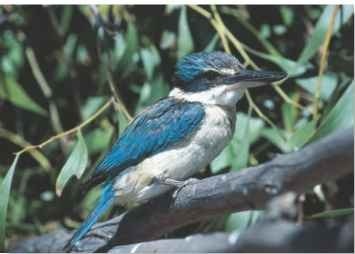
A Woodland wonder The sacred kingfisher’s bright blue and white plumage stands out among the green foliage.
The sacred kingfisher favors the woodlands of Australia and New Zealand, especially stands of eucalyptus near water. The bird is common in red-gum woods and mangroves, as well as along seashores and offshore islands. Sacred kingfishers also range throughout the acacia scrub in western Australia, melaleuca swampland in the north or anywhere they can find a tree hole, bank or termite mound for nesting. The bird winters in Sumatra, Borneo, New Guinea and surrounding islands, and prefers parkland, open country, gardens, savannahs and wooded roadsides, which offer a steady supply of food.
conservation
Sacred kingfisher populations are extremely strong. The sacred kingfisher lives in two-thirds of Australia, with 3-30 birds found per sq. mile. It is estimated that there are more than 10 million kingfishers living in Australia alone. There appears to be no threat to this number as long as the sacred kingfisher’s habitat is preserved.
Breeding
Sacred kingfisher pairs mate for life and live together year-round. They excavate nest holes, with sites varying between regions: in west Australia, the birds use tree holes; in the east, they use earth banks by streams; on the central New South Wales coast, they use tree termitaria (termite mounds). The female does most of the incubating of the 3-6 eggs. The young hatch blind and naked, with fleshy legs; their bodies, including the heels, are covered in horny papillae — small proiections that later form colorful plumage. The young stand on their heels, using the papillae like the ridges on athletic shoes. The young fledge in about 24 days.
► New home The sacred kingfisher never uses another bird’s old nest — it excavates its own.
Behavior
The sacred kingfisher travels mainly in pairs and vigorously defends its territory. It uses loud, repetitious calls to chase away other birds, and spreads its wings, exposing its patterned undersides. The vocal bird sounds 12 loud staccato notes in a slightly descending scale. The cries change when nesting; then the bird emits a chuckling ch-rr-k. Migrations can reach up to 2,400 miles, with the majority of birds flying northward to winter near the north Australian coast and in Indonesia, Borneo, Sulawesi, New Guinea, the Bismark archipelago and the Solomon Islands. Sacred kingfishers move at night and cross the Torres Strait in great numbers from late September to late October: Most kingfisher species dig nesting burrows in a bank, but often there is a shortage of these sites. The birds then use natural holes in dead trees or dig into termite mounds in trees.
home sweet home
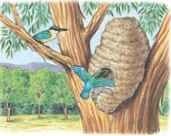
Location, location…
A male and female kingfisher prepare to dig out a termite’s mound found in the fork of a eucalyptus tree trunk.
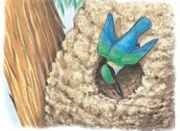
All work and no play…
They take turns fixing up their future home. The male performs a daredevil feat by hanging upside down to chisel an entrance hole.
Kingfishers used one nest site in a tree in New Zealand for 17 years.
According to Greek mythology, Alcyone found her husband drowned and then threw herself into the sea. For her devotion, the gods turned her into a kingfisher, hence the genus name Halcyon.
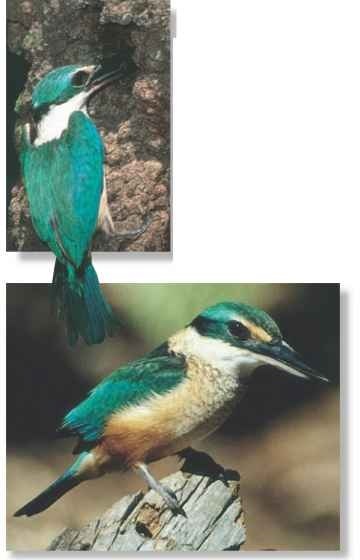
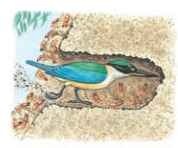
Her turn…
Adding the finishing touches, the female kicks the soil back toward the entrance.Termites try to seal the damaged parts of their home.
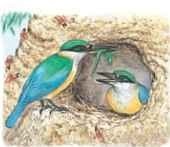
The reward
Holding a lizard in its bill, the male offers it to the female, who has made herself comfortable inside the finished nest.
Food & hunting
The sacred kingfisher is a patient hunter; it finds a strategic spot and scans an area for prey, preferring to perch low in the forest or in a mangrove swamp. It looks for insects, such as grasshoppers, dragonflies, cockchafers, beetles, grubs and caterpillars. The sacred kingfisher also hunts for spiders, freshwater fish, crayfish, frogs and lizards seized from saltwater shallows and rocks at low tide. It moves its head to scan for prey and periodically flicks its tail upward in anticipation. Once it identifies its meal, it dives down, scooping up the prey in its bill and returning to the perch, where the catch is beaten into submission and swallowed whole. Sacred kingfishers living near the sea dive into sand, mud and water for their meal.They also hover over foliage to snatch a snack The parents bring protein-rich insects to their young; when nestlings fledge, they begin their own hunting expeditions. The young birds quickly become good hunters, because their prey is slow-moving and on the ground.
Gotcha
An unlucky lizard has lost its tail to no avail in its attempts to escape.
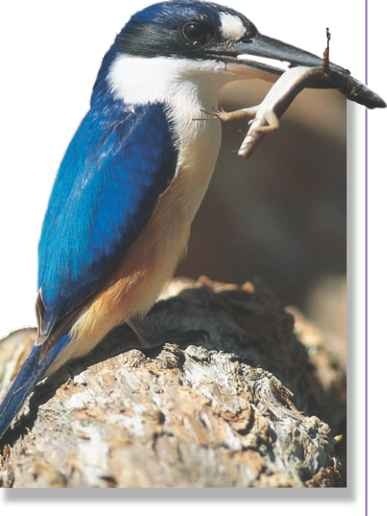
Profile
Sacred Kingfisher
The sacred kingfisher uses its prominent bill to snap up prey from the water, but it prefers the easier task of snagging an insect on the ground.
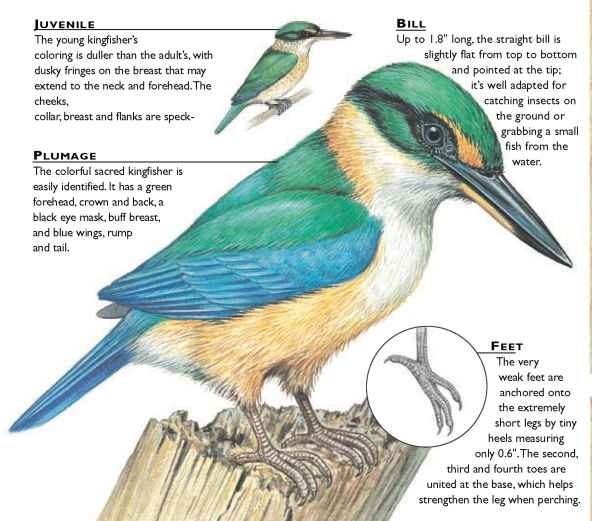
Creature comparisons
The unmistakable markings of the yellow-billed kingfisher (Halcyon tortoro) include a _— yellow bill and legs and a rich rufous head and breast with a large black patch on the nape. Slightly smaller than the sacred kingfisher; the yellow-billed kingfisher is common throughout lowland New Guinea. Unlike its relative, the 8″ long yellow-billed kingfisher does not migrate. When hunting for prey, it sways from side to side on its perch and lands on the ground with a “thump.” Yellow-billed kingfisher
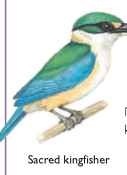
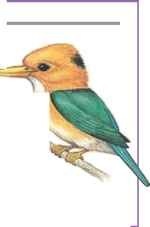
| VITAL STATISTICS Weight 1-2 oz. |
|
| Length | 8.5″ |
| Wingspan | 11.5-13.5″ |
| Sexual Maturity | About 1 year |
| Breeding Season | Varies according to region |
| Number of Eggs | 3-6 |
| Incubation Period | 18 days |
| Fledging Period | 24 days |
| Breeding Interval | Up to 1 year |
| Typical Diet | Insects, , spiders, fish, frogs, birds and crabs |
| Lifespan | Unknown |
RELATED SPECIES
• The sacred kingfisher is one of 56 woodland species of kingfisher in the genus Halcyon, which join about 30 other species in the family Alcedinidae. One of the most widely known of the true fishing kingfishers is the belted kingfisher, Megaceryle alcyon, of North America. The order Coraciiformes includes kingfishers along with motmots, I bee-eaters, rollers, hoopoes and hornbills.
